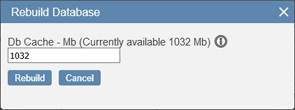The MyStandard Page - Rebuild Database command
This page describes the 'Rebuild Database' command in MyStandard.
---
The 'Rebuild Database' command on the MyStandard page will first create a back-up from your server database, then import that back-up into a new database. This new database will become the live database. Follow these steps:
- Log in to MyStandard. If you are already logged in, you may need to select 'Companies' in the main menu at the top of the window.
- If you have more than server, select the one you want to work with in the list on the left-hand side of the window.
- It is usually recommended that you stop the server before rebuilding the database. When you stop the server, you will be able to send a message to any users currently logged in asking them to save their work. If you rebuild without stopping first, the rebuilding process will close the server without any warning to the users.
- Press 'Rebuild Database'. This command will only be visible if you have Admin Access to the server on MyStandard.

- The 'Rebuild Database' window will appear.

In the Db Cache field, you can optionally enter as a number of Mb how much memory you would like to be used as the database cache when importing to the new database. The recommended maximum is 80% of the memory that is available on your server. If MyStandard can establish your server's memory size, this recommended maximum will be displayed in the 'Rebuild Database' window as a guide.
- Press 'Rebuild Database' to begin the rebuilding process. The existing database file will first be renamed (the current date will be added to the filename as a suffix, "HANSA.HDB-YYYYMMDD"), a new database will then be created and the back-up will be imported. Finally, the new server will be started automatically. The rebuild will be added to the Server Activity Log. On the MyStandard page, the Status will change to "Rebuilding Database", and then to "Running". The "Running" Status signifies that the rebuild has finished and that clients can log in.
---
About MyStandard:
Go back to:
